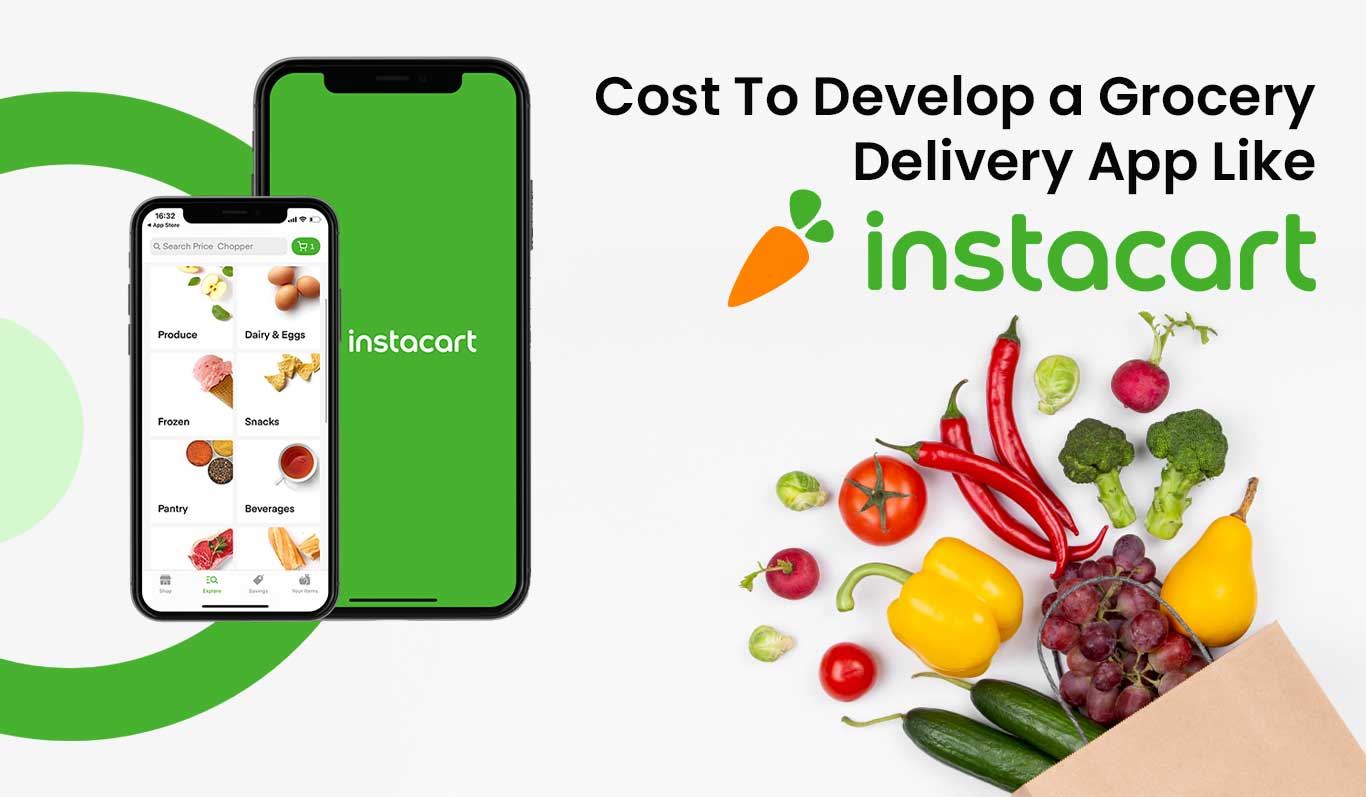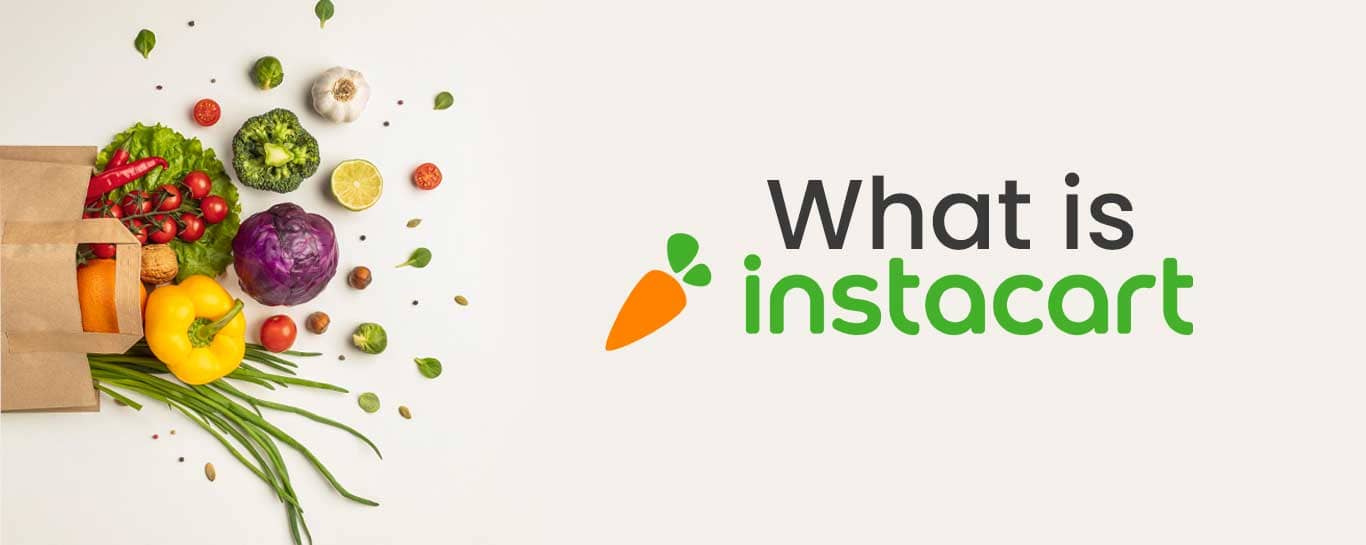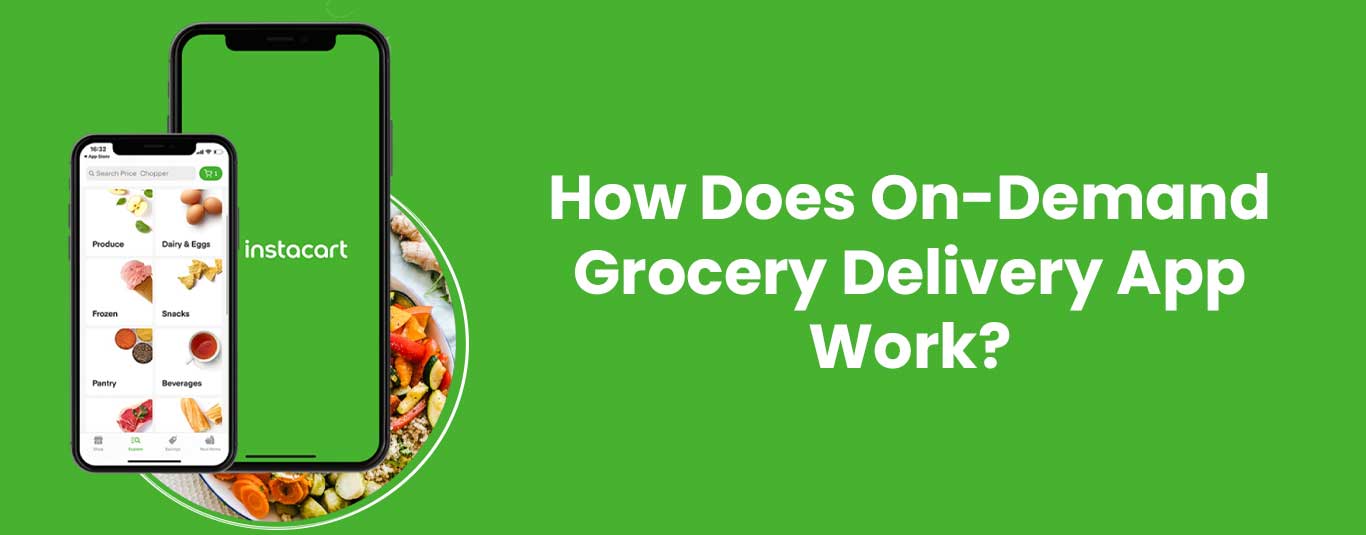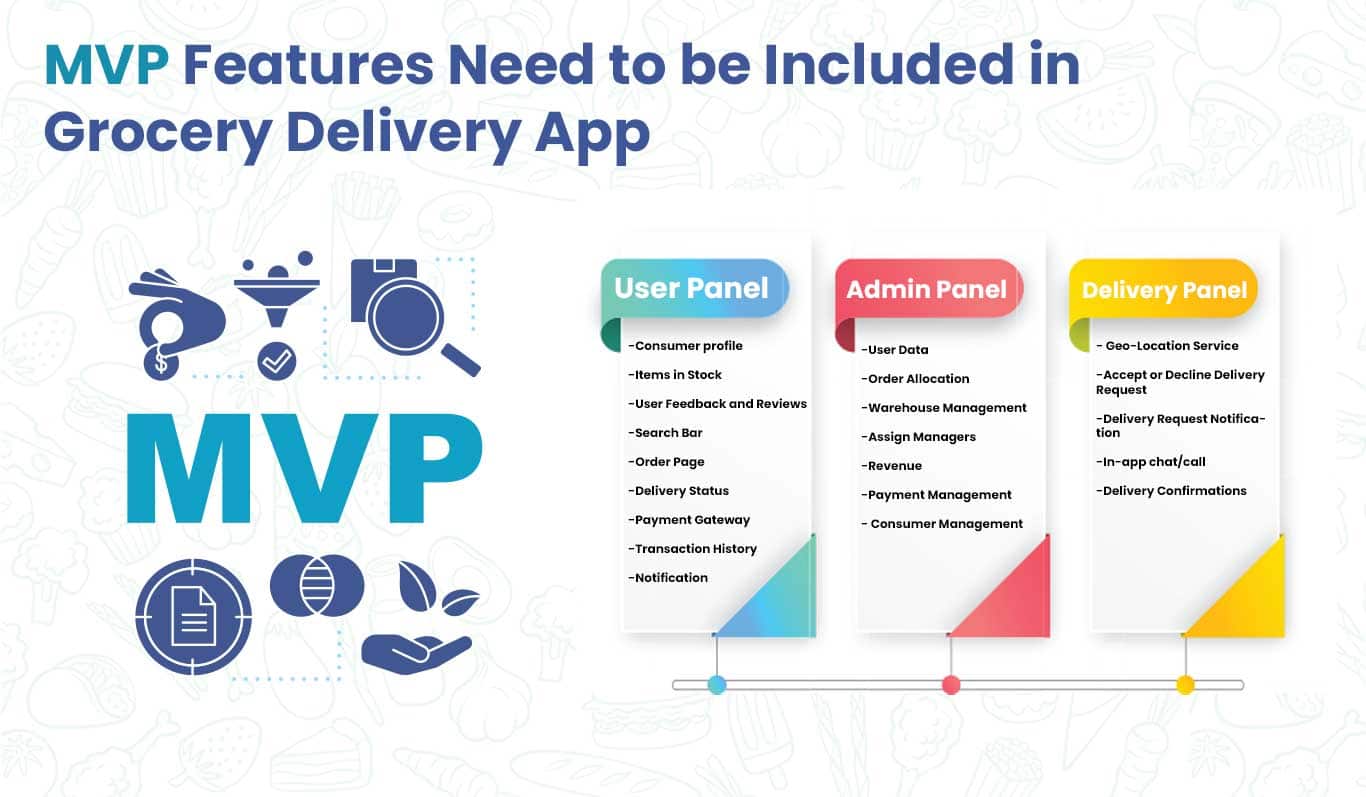Cost to Develop a Grocery Delivery App Like Instacart

Hungry for good food? Then why wait? Order your favorite meal instantly through Instacart. Hunger cravings increased among people during the lockdown. During pandemic people were running short of main ingredients while cooking delicious recipes.
Before 2020 grocery delivery apps were not much popular, people used to visit restaurants or food stalls to have their favorite food, but during the lockdown, people became very lazy to purchase groceries from stores, since then people started to order food and groceries online from on-demand online delivery apps.
On-demand grocery delivery app services allow individuals to order anything and everything from online delivery apps and it will get delivered to your doorstep without any hassle.
According to McKinsey, the market share for online grocery delivery at homes in various European nations will reach up to 30% in the future. It is also expected that online grocery delivery apps in the US would reach 20.5%, and by 2025, the average yearly expenditure per online grocery consumer will rise to $1,524.84 from $856.47.
What is Instacart?
Instacart is an online grocery delivery app development service founded by Apoorva Mehta and Max Mullen in 2012. Instacart is a grocery delivery app platform that delivers groceries and other essential items to the doorstep in US and Cannada. Instacart headquarters are in San Francisco, California, the company is driven by a business model and its main objective is to deliver groceries within an hour.

Instacart stats:
Instacart has experienced significant growth since its launch and has established itself as a major player in the online grocery delivery industry. The company has expanded its reach by partnering with more grocery stores, launching new services, and entering new markets, and it continues to explore new opportunities for growth and innovation.
-
Greater than 200,000 buyers
-
Instacart has reached up to 30,000 retailers
-
More than 500 million goods are listed on Instacart.
-
5,500 cities across North America are served by Instacart.
-
Instacart is accessible to 85% of households in the United States.
-
By the end of July 2020, Instacart has 8% of all online consumer goods sales in the United States.
In 2018 Instacart had raised $8 billion and it went up to $13.7 billion it was led by DST Global and General Catalyst. An investment of $225 million was made by Instacart in June 2020.
How Does On-Demand Grocery Delivery App Work?
A well-known online grocery delivery service like Instacart, delivers the order within five hours of order being placed. App users can check out products, add items to their shopping carts, and schedule deliveries. Instacart app doesn’t have its own warehouse, if the item listed in the shopping cart is not available then the app will help buyers by showing the alternative to that product.

-
Any order above $35 that is delivered within the scheduled time or two hours will cost the consumer $3.99.
-
Additional costs are $5.99 for items to be delivered within an hour.
-
If the user's order is less than $35, then the app will cost $7.99 for delivery within two hours and $9.99 for delivery within one hour.
-
Users of Instacart can purchase a membership for $99 that includes free deliveries.
Top 5 famous Business Model of Instacart Grocery Delivery App
To run a successful grocery delivery company, this famous business model must be implemented within the app.
Warehouse Model
The inventory model is used to make single-product stores more convenient. A platform using this technique will source its products directly from various suppliers. The orders will be picked up from the clients and delivered through an internal or external network to the necessary place.
Various firms use the warehouse model to understand how the delivery of goods works and the stability of an app. When a business manages its supply chain and purchases directly from a company its profit margin automatically increases. One such example is Big Basket they sell their products to retailers, and distributors and then store the products in their inventories.
Construction of inventory, inventory administration, transportation, and quality control all these requirements are a bit costly.
If some of the products are not utilized within the set time frame, then users can remove these products, and can be considered a first investment

Multi-Vendor Marketplace Model
Many platforms don’t keep their own stock of goods and then the multi-vendor marketplace acts as a bridge between consumer and shop owner so that the consumers can purchase their listed groceries and it will be provided to the stores directly.
Internal logistics handle shipping services that let the company hassle-free grocery shipping to its consumer and it is shipped under the store name. The multi-vendor marketplace model has become so popular because it has given huge success to an online grocery marketplace.
Shopping Model
One of the top most famous used models is the shopping model. Its concept is similar to a multi-vendor marketplace model. A user is not given the option to choose the grocery shop to purchase a product. When a consumer places an order, the platform sends that order to the vendors, then they purchase the items and deliver them to the customers.
Hyper Local Marketplace Model
A hyper-local market caters to the needs of customers in limited geographic areas. Hyper Local Market is small and has fewer items, it is self-sufficient and serves practically all of the requirements of the locals.
The model's three-tier customer approach is:
The enthusiasm of enterprises using a hyper-local business model to supply goods and services in a flash is their unique selling strategy. The ordering and delivery processes for numerous on-demand grocery markets have undergone a drastic change.
ECommerce Business Model
Companies with an eCommerce business model or online selling model have various channels as a source of income. The established multi-vendor platforms and the grocery supply create the most sales. Merchandising, commissions, subscriptions, service fees, promotions, memberships, etc. are a few of the often-used income sources.
Instacart partners with local grocery stores to source the products that customers order, and then uses a network of personal shoppers to pick and pack the items and deliver them to customers. Customers can place orders through the Instacart website or mobile app, and they can choose from a variety of delivery options, including same-day delivery and scheduled delivery.
Instacart generates revenue by charging customers a delivery fee, as well as a markup on the prices of the products they order. The company also earns money through subscription fees for its premium service, Instacart Express, which provides customers with unlimited free delivery for an annual or monthly fee.
Instacart's e-commerce business model leverages technology to streamline the grocery delivery process and offer customers a convenient and reliable shopping experience.
MVP Features Need to be Included in Grocery Delivery App

User Panel
The Instacart user panel refers to the platform's interface where users can place orders for groceries to be delivered to their homes. The user panel includes features such as browsing and searching for products, adding items to a cart, selecting a delivery time slot, and checking out. Users can also access their previous orders, update their payment and delivery information, and leave feedback for their delivery experience.
-
Consumer profile
-
Items in Stock
-
User Feedback and Reviews
-
Search Bar
-
Order Page
-
Delivery Status
-
Payment Gateway
-
Transaction History
-
Notification
Admin Panel
The Instacart admin panel is a platform interface that provides tools and features for managing and monitoring the delivery service. This panel is used by Instacart employees, such as managers and operators, to overview the delivery process, manage delivery personnel, and monitor performance metrics.
The admin panel include features such as viewing real-time delivery data, managing orders, monitoring delivery personnel, and analyzing performance metrics. The features available in the Instacart admin panel can vary based on the needs of the company and the role of the user.
-
User Data
-
Order Allocation
-
Warehouse Management
-
Assign Managers
-
Revenue
-
Payment Management
-
Consumer Management
Delivery Panel
The Instacart delivery panel is an interface that is used by Instacart delivery personnel to manage their deliveries. The delivery panel includes features such as viewing assigned delivery orders, updating delivery status, accessing delivery instructions and maps, and communicating with customers.
The delivery panel is designed to provide delivery personnel with all the information they need to complete their deliveries efficiently and effectively. It also ensures that customers receive their groceries in a timely and accurate manner. The delivery panel can vary based on the needs of the company and the role of the delivery personnel.
-
Geo Location Service
-
Accept or Decline Delivery Request
-
Delivery Request Notification
-
In app chat/call
-
Delivery Confirmations
How Much Does It Cost to Build a Grocery Delivery App Like Instacart

For a Instacart grocery delivery app development, cost estimation would be based on the features used. The complex features used to create an app, development company location, target audience, and the number of platforms used all determine the cost of grocery app development.
-
In Easter Europe grocery app developers will cost around $79 per hour to $140 per hour.
-
In S.A grocery app developers will cost- $50 per hour to $240 per hour
-
Indian grocery app developers will cost approx. $15 per hour to $85 per hour
The cost to develop an on-demand grocery delivery app has very limited features
-
Technical documentation will cost -$1000-$2500
-
QA and Testing will range around - $2500-$4000
-
UI/UX will cost approximately -$1500-$3700
-
Front-end and Backend developers will cost $15000-$30000
On average, the cost to develop a grocery delivery app like Instacart on a single platform Android or iOS will cost about $15000 to $30000. However, the developing cost differs depending on the complexity of a grocery app development.
Contact Us! To know more about the grocery market, with the right technology and expert team, our software app development company will help you create a distinctive grocery delivery app.
Request a Quote
Categories
Popular posts
Best Practices for Software Product Engineering Every CTO Should Implement
2023-14-18How to Build Your Own On-Demand Carpooling App Services?
2023-08-25How to Start an On-Demand Fuel Delivery Business: A Comprehensive Guide
2023-07-28Empowering Miners: How Fleet Management Apps are Transforming the Mining Industry?
2023-07-21A Complete Guide to Develop a Food Delivery App for Restaurants in 2023
2023-07-08Mobile Apps Transforming the Travel Industry: A Game-Changer in Travel Planning and Experience
2023-07-07
